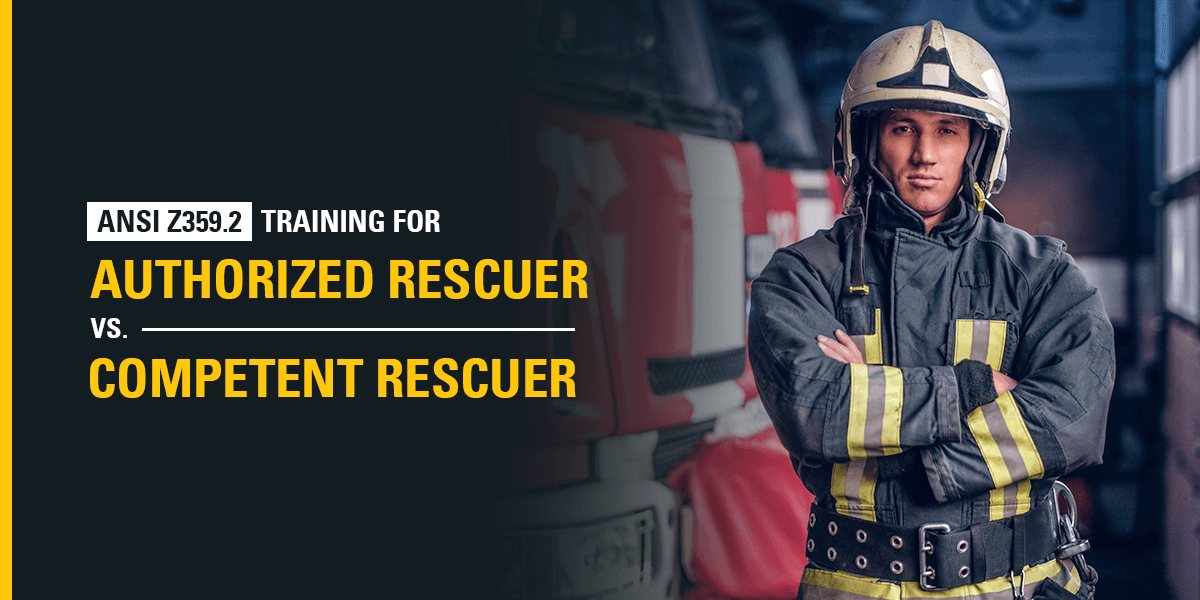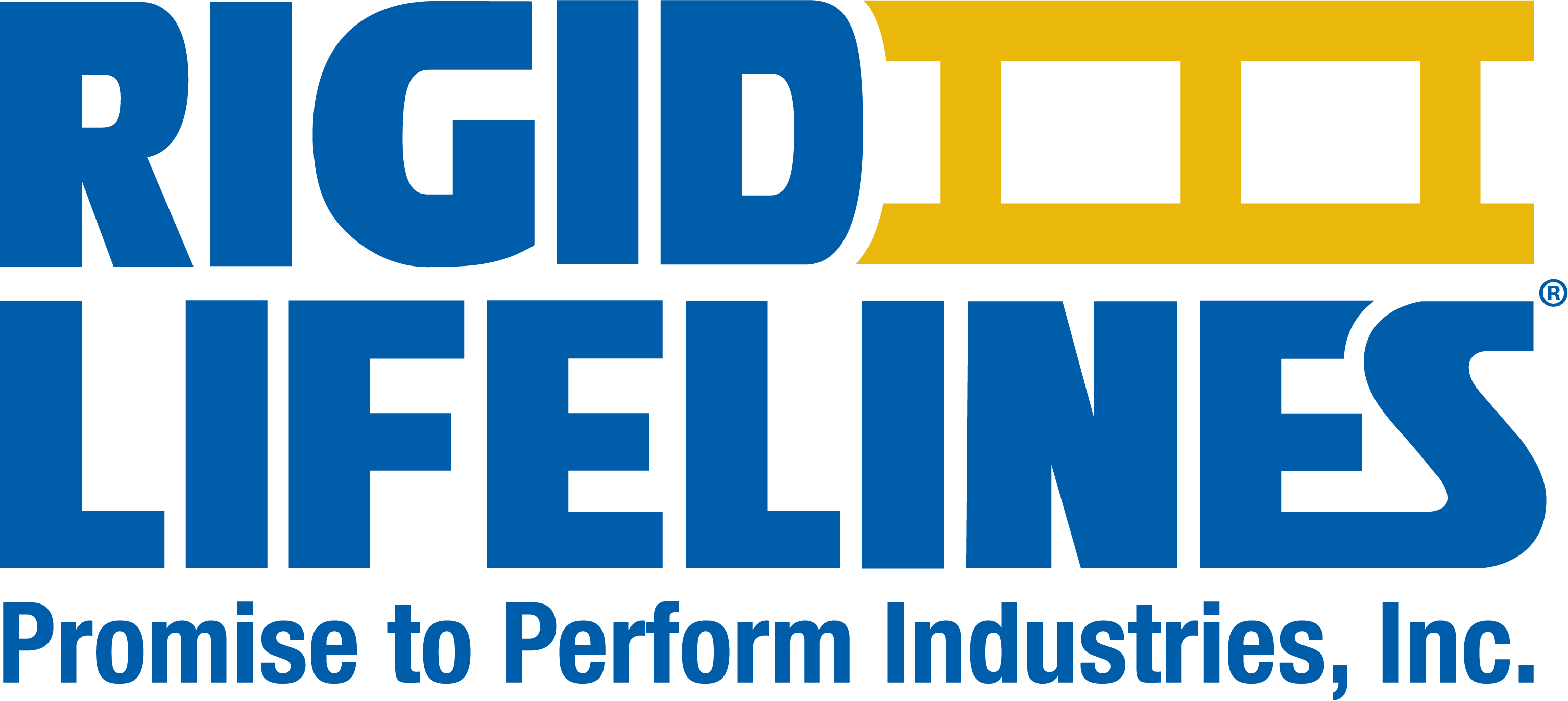
ANSI Z359.2: Training for Authorized Rescuer vs. Competent Rescuer
May 19, 2025
As workplace falls increase in industrial and construction facilities, more employers are installing fall protection systems. While many employers will teach workers how to use the system, they can overlook the logistics of rescuing the worker after a fall event has occurred. The fall rescue is equally as important as the fall arrest. This is why understanding the logistics of how employers determine who will be an Authorized Rescuer is important.
ANSI Z359 Standard (Section 2) defines different terms that pertain to fall protection. Several definitions discuss the various roles of rescuers and their qualifications for retrieving people after a fall. Below, we cover the different ANSI safety training standards for Authorized Rescuers and Competent Rescuers.
What Is an Authorized Rescuer?
ANSI defines an Authorized Rescuer as “A person assigned by the employer to perform fall protection rescue.” This straightforward definition does not establish any specific training that people need to have to rescue someone from a fall protection system, but it does establish that this rescuer needs to be selected by the employer.
What Is a Competent Rescuer?
ANSI defines a Competent Rescuer as “An individual designated by the employer who, by training, knowledge, and experience, is capable of the implementation, supervision, and monitoring of the employer’s fall protection rescue program.” Employers who want rescue personnel with more experience and education in fall rescue would probably consider hiring a Competent Rescuer.
A Competent Rescuer differs from an Authorized Rescuer because they have more education and experience with situations regarding fall rescue. A Competent Rescuer also has more responsibility because they decide when to implement fall rescue at a facility or jobsite. Simply put, the Competent Rescuer manages all facets of the fall rescue program to ensure everything is implemented smoothly in the event of a fall.
Key Differences and Training Requirements
An Authorized Rescuer requires slightly less training than a Competent Rescuer. However, both titles require basic training to understand fundamental fall protection safety and rescue techniques.
Authorized Rescuer
The core of an Authorized Rescuer’s training is based on several different criteria. First, the training must be conducted by a Competent Rescue Trainer. It will include physical demonstrations for:
- Inspecting the equipment.
- Anchoring and assembling the equipment properly.
- Using the equipment in their common working areas.
Once the general instructions have been completed, rescue training includes how to recognize, eliminate, and control fall hazards. Situational fall protection and rescue regulations according to OSHA and ANSI are other critical components to properly training rescuers. They will also need to know their responsibilities under ANSI.
The final two elements of a comprehensive Authorized Rescuer training course are:
- Interpreting written fall protection and rescue procedures.
- Properly inspecting equipment components and systems before each use.
Authorized Rescuers need to be trained every two years and perform annual rescue drills. If changes are made to the requirements of a position, a worksite changes location dramatically, or rescue methods change (making the old method irrelevant), a rescuer will need to undergo training again.
Competent Rescuer
Competent Rescuers are required to be trained annually by a Competent Rescue Trainer. In addition to following the training for an Authorized Rescuer, the Competent Rescuer needs to take some extra courses. Training must include demonstrations about fall protection equipment, covering how to select and inspect the equipment. Then, rescue trainers need to learn to anchor, assemble, and use the fall protection and rescue equipment where they will be needed at the worksite.
Competent rescue training will cover information about all types of rescue equipment and hazardous locations. Pre-use inspection, installation, and component compatibility are all important elements to understand about rescue systems. Rescuers will also need to learn about:
- Descent control.
- Secondary systems.
- Patient packaging methods.
- Dismantling techniques.
- Proper storage of equipment.
- Selection and use of fall protection anchors.
- Common hazards that pertain to the system and components.
Once workers have learned how to use, install, and maintain the rescue equipment, they will learn how to perform detailed inspection and documentation of the components of the rescue equipment and systems. They will also learn how to evaluate a system to determine if it is reliable for use. Finally, a Competent Rescuer will develop written fall rescue procedures for their workplace.
Understanding Competent Rescue Trainers and Rescue Systems
Often, people who have experience in fall rescue could officially be titled as either a Competent Rescuer or a Competent Rescue Trainer. This is because ANSI Z359 Standard defines these titles similarly. The official definition for a Competent Rescue Trainer is “An individual who, by training, knowledge, and experience specific to fall protection rescue, is capable of conducting rescue training.” Although the level of experience with fall protection is the same, the responsibilities of each title are very different.
The Competent Rescuer needs a thorough understanding of everyone who will be involved with a fall rescue at a facility or on a jobsite. However, the Competent Rescue Trainer needs a complete understanding of the different methods that can be used for rescuing someone in a variety of circumstances. With each title, the person must have enough experience and knowledge about fall rescue to either manage or train people.
Holistically, ANSI Z359 Standard offers an all-purpose definition of a Rescuer in this section of the standards. A Rescuer is defined as “A person or persons other than the rescue subject acting to perform an assisted rescue by operation of a rescue system.” A Rescuer could be anyone who is asked to participate on a rescue team thanks to the brains or brawn that they could add to a rescue.
In some instances, the Competent Rescuer may decide to implement a Rescue System. Under the ANSI Z359 Standard, a Rescue System is defined as “An assembly of components and subsystems used for rescue.” It’s a broad definition for a broad term. Essentially, any tool used for rescuing someone from a fall protection system could be considered a Rescue System.
The Importance of Proper Training
This may seem like a lot of information to learn about a proper rescue plan. However, Authorized and Competent Rescuers will need training in all of these subjects to be prepared to perform a fall rescue. Training ensures that rescuers can handle almost any situation that they may encounter after a fall event has occurred.
To reduce the chances of suspension trauma, it is often wise to have on-site workers trained in fall rescue. Having an on-site rescue team allows for almost immediate assistance for a fallen worker, but local fire companies and police departments can also be effective in assisting with a fall rescue. Regardless of who performs the rescue, the most important concept is to ensure that the rescue team has been trained according to ANSI Z359.2 standards.
Furthermore, here are some general reasons why comprehensive fall protection training is nonnegotiable on jobsites:
- Reduced risk of injuries and fatalities: Falls are a leading cause of workplace injuries and fatalities. Proper training equips personnel with the skills and knowledge to use equipment safely and implement preventive measures to minimize incidents. They can detect potential fall hazards and unsafe conditions, such as unprotected edges, slippery surfaces, and insufficient scaffolding. Teams can significantly reduce or even eliminate accidents by addressing these risks proactively.
- Compliance with safety regulations: Regulatory bodies in the United States, such as OSHA, have stringent requirements regarding fall protection training. Employers can ensure regulatory compliance and avoid penalties by conducting proper training.
- Improved equipment health and lifespan: Fall protection equipment — such as lanyards, safety nets, and harnesses — is only effective when used correctly. Thorough training teaches employees how to inspect, wear, use, and remove the equipment. Aside from keeping them safe, these proper techniques also help reduce damage to the equipment, ultimately extending its use and service life.
- Enhanced productivity: When workers receive comprehensive training to perform their jobs safely and confidently, overall productivity increases in the workplace.
- Cost savings: Between workers’ compensation claims, medical expenses, and lost productivity, fall-related accidents and injuries can be costly for employers. Investing in a fall protection training program helps reduce or eliminate these costs.
- Safety culture in the workplace: Fall protection training promotes safety on worksites. It helps cultivate a safety-conscious work environment where team members are encouraged to identify and report hazards, exercise correct equipment use, and prioritize safety in all aspects of their work.
The Importance of Proper Equipment
Having the right equipment is crucial to protect employees from fall-related injuries and fatalities. At Rigid Lifelines®, we provide fall protection systems for construction sites and numerous other industries. Our solutions can be used indoors and outdoors and are compliant with ANSI and OSHA standards.
Our Anchor Track™ fall protection solutions include:
Mobile Fall Arrest Overhead Systems
When you can’t mount a permanent fall protection system to your building or you only have temporary fall protection requirements, a mobile fall arrest system may serve your needs. These systems come in both standard and custom configurations to meet your unique specifications.
Our Mobile Fall Arrest Overhead Systems are ideal for temporary worksites or rented facilities where fall arrest systems are relocated constantly. They’re perfect when you need to move your system between different facilities or areas within your building. These mobile systems offer the convenience you need, plus the reliability of a standard rigid enclosed track.
Permanent Overhead Fall Protection Systems
Our permanent fall protection systems are suitable for jobsites where employees are regularly exposed to fall hazards. Anchor Track™ Permanent Overhead Systems are available in various sizes and styles to accommodate different facility requirements, applications, and industries.
These designs include freestanding, wall-mounted, ceiling-mounted, and foldaway units. Fall protection systems that fold into themselves also enable easy storage, preserving valuable space in your facility.
Request More Information About ANSI Training Standards or Fall Protection Systems
Hopefully, this blog gave you a better idea of the different roles and responsibilities of various rescue personnel who can assist your employees after a fall event. If you have any other questions about the authorizations or expectations of different rescuers at a facility or jobsite, please leave your question below and we will gladly help you.
If you’re interested in a temporary or permanent fall protection solution from Rigid Lifelines®, use our System Selector to find the best fit for your facility or locate a sales representative near you.
Categories
Share this post
Let us help you
Contact us today to find the perfect product fit for your job
